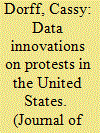| Srl | Item |
| 1 |
ID:
190027


|
|
|
|
|
| Summary/Abstract |
For decades, the United States has been generally excluded from cross-national quantitative datasets on the study of collective action and political resistance. More recently, however, new data collection efforts are on the rise. These projects specifically focus on gathering granular level information about street protests and mobilizations in the United States. In this article, we conduct a rigorous exploratory data analysis of three contemporary protest datasets. These data collect information about the when, where and how of contentious politics in the United States. Our thorough data review first summarizes the key similarities and differences across the datasets. Next, we review the regional, temporal and methodological strengths and weaknesses of each dataset both individually and in contrast to one another. Last, we examine potential research applications of these data by demonstrating what these data reveal about the risks of protesting in these types of events. We conclude by offering recommendations for data use and future data collection strategies for the study of collective action.
|
|
|
|
|
|
|
|
|
|
|
|
|
|
|
|
| 2 |
ID:
164169


|
|
|
|
|
| Summary/Abstract |
From armed-building occupations to fisticuffs between protesters and police at otherwise peaceful demonstrations, protest violence is an essential part of the politics of protest. In this article, I argue that state capacity is central to understanding why some protests are violent. In particular, this article explores two facets of state capacity—coercive capacity and state authority—arguing that where the state is treated as a relevant authority, the likelihood that protesters will employ violent tactics decreases. Using original data on Mexican protest events, I demonstrate that higher levels of state authority reduce violent protest but that increased coercive capacity, especially where state authority is weak, is associated with a greater likelihood of protest violence. This article contributes to our understanding of the influence of state capacity on protest violence and suggests that attentiveness to subnational variations in state capacity can help us better understand the violence.
|
|
|
|
|
|
|
|
|
|
|
|
|
|
|
|